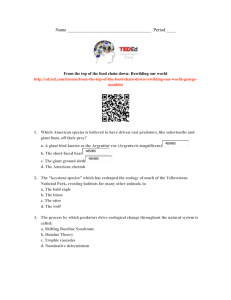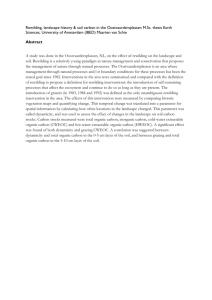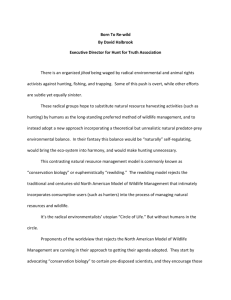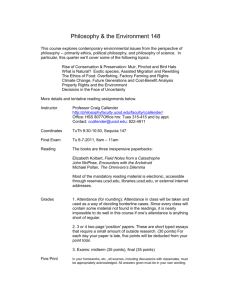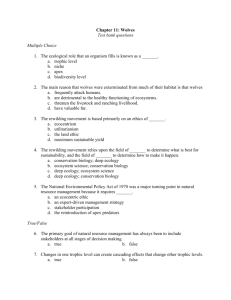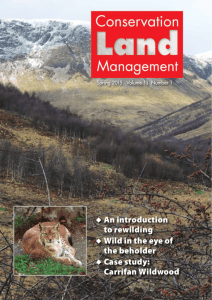Rewilding in Spain: Where is it Possible and
advertisement
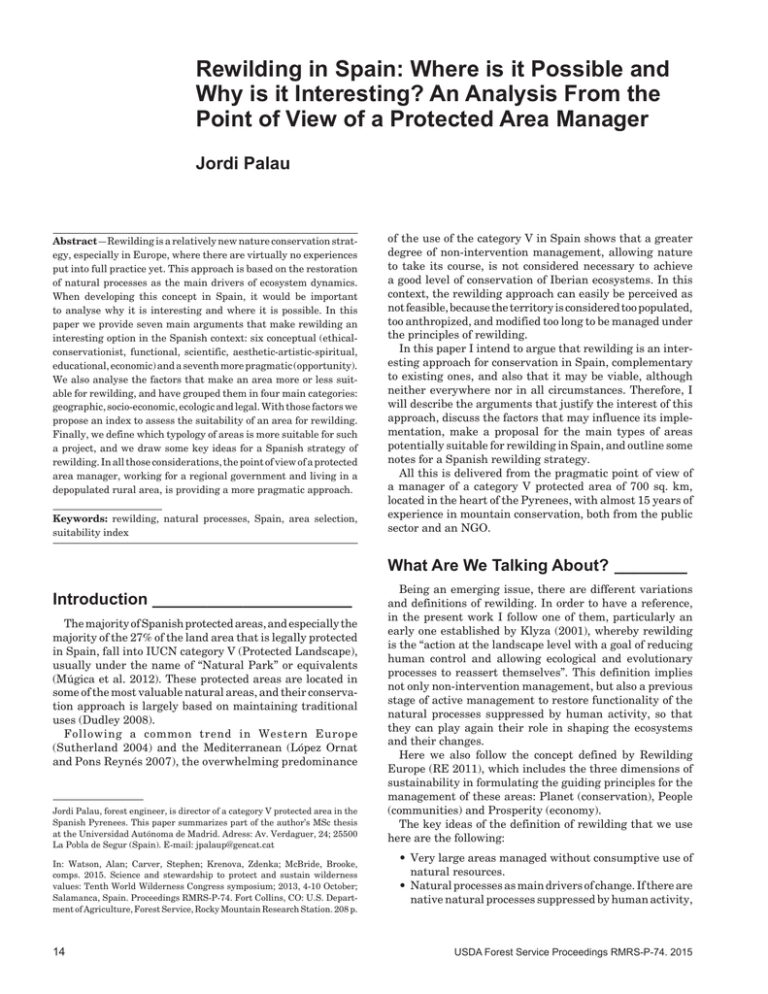
Rewilding in Spain: Where is it Possible and Why is it Interesting? An Analysis From the Point of View of a Protected Area Manager Jordi Palau Abstract—Rewilding is a relatively new nature conservation strategy, especially in Europe, where there are virtually no experiences put into full practice yet. This approach is based on the restoration of natural processes as the main drivers of ecosystem dynamics. When developing this concept in Spain, it would be important to analyse why it is interesting and where it is possible. In this paper we provide seven main arguments that make rewilding an interesting option in the Spanish context: six conceptual (ethicalconservationist, functional, scientific, aesthetic-artistic-spiritual, educational, economic) and a seventh more pragmatic (opportunity). We also analyse the factors that make an area more or less suitable for rewilding, and have grouped them in four main categories: geographic, socio-economic, ecologic and legal. With those factors we propose an index to assess the suitability of an area for rewilding. Finally, we define which typology of areas is more suitable for such a project, and we draw some key ideas for a Spanish strategy of rewilding. In all those considerations, the point of view of a protected area manager, working for a regional government and living in a depopulated rural area, is providing a more pragmatic approach. Keywords: rewilding, natural processes, Spain, area selection, suitability index of the use of the category V in Spain shows that a greater degree of non-intervention management, allowing nature to take its course, is not considered necessary to achieve a good level of conservation of Iberian ecosystems. In this context, the rewilding approach can easily be perceived as not feasible, because the territory is considered too populated, too anthropized, and modified too long to be managed under the principles of rewilding. In this paper I intend to argue that rewilding is an interesting approach for conservation in Spain, complementary to existing ones, and also that it may be viable, although neither everywhere nor in all circumstances. Therefore, I will describe the arguments that justify the interest of this approach, discuss the factors that may influence its implementation, make a proposal for the main types of areas potentially suitable for rewilding in Spain, and outline some notes for a Spanish rewilding strategy. All this is delivered from the pragmatic point of view of a manager of a category V protected area of 700 sq. km, located in the heart of the Pyrenees, with almost 15 years of experience in mountain conservation, both from the public sector and an NGO. What Are We Talking About?_________ Introduction_______________________ The majority of Spanish protected areas, and especially the majority of the 27% of the land area that is legally protected in Spain, fall into IUCN category V (Protected Landscape), usually under the name of “Natural Park” or equivalents (Múgica et al. 2012). These protected areas are located in some of the most valuable natural areas, and their conservation approach is largely based on maintaining traditional uses (Dudley 2008). Following a common trend in Western Europe (­Sutherland 2004) and the Mediterranean (López Ornat and Pons Reynés 2007), the overwhelming predominance Jordi Palau, forest engineer, is director of a category V protected area in the Spanish Pyrenees. This paper summarizes part of the author’s MSc thesis at the Universidad Autónoma de Madrid. Adress: Av. Verdaguer, 24; 25500 La Pobla de Segur (Spain). E-mail: jpalaup@gencat.cat In: Watson, Alan; Carver, Stephen; Krenova, Zdenka; McBride, Brooke, comps. 2015. Science and stewardship to protect and sustain wilderness values: Tenth World Wilderness Congress symposium; 2013, 4-10 October; Salamanca, Spain. Proceedings RMRS-P-74. Fort Collins, CO: U.S. Department of Agriculture, Forest Service, Rocky Mountain Research Station. 208 p. 14 Being an emerging issue, there are different variations and definitions of rewilding. In order to have a reference, in the present work I follow one of them, particularly an early one established by Klyza (2001), whereby rewilding is the “action at the landscape level with a goal of reducing human control and allowing ecological and evolutionary processes to reassert themselves”. This definition implies not only non-intervention management, but also a previous stage of active management to restore functionality of the natural processes suppressed by human activity, so that they can play again their role in shaping the ecosystems and their changes. Here we also follow the concept defined by Rewilding Europe (RE 2011), which includes the three dimensions of sustainability in formulating the guiding principles for the management of these areas: Planet (conservation), People (communities) and Prosperity (economy). The key ideas of the definition of rewilding that we use here are the following: • Very large areas managed without consumptive use of natural resources. • Natural processes as main drivers of change. If there are native natural processes suppressed by human activity, USDA Forest Service Proceedings RMRS-P-74. 2015 Rewilding in Spain: Where is it Possible and Why is it Interesting? An Analysis From the Point of View of a Protected Area Manager Palau and Pyrenees they should be actively restored through management action. • Change is not intrinsically negative: for instance, it is not necessary to have always a forest where there is a forest now. • Rewilding is not only about species reintroduction; other processes such as fire or flooding should be restored using the appropriate techniques. • Non-consumptive economic activities (e.g. tourism) and even villages are possible within the rewilding areas. This argument has an added advantage: these places can become areas of conservation without conflict (Noss et al. 1999). For example, where there is no livestock or hunting, the wolf (the main driver of the process of predation on large mammals) is not a problem; where there is no need for logging or other forest products, wildfires or plagues are not a problem. In short, where there are no human interests likely to be harmed, natural processes do not cause conflicts and can freely play their ecological and evolutionary role. When we talk about natural processes as drivers of ecosystems, we need to know what processes are suppressed due to human activity. Snow avalanches, for example, have continued to operate significantly in mountainous areas, but some other processes are no longer active. The main suppressed natural processes in Spain are fire, flooding (and the free flowing of water), ecological succession resulting in old-growth forests, and almost all the large vertebrate-mediated processes (herbivory with the complete guild of native ungulates, predation and, to a lesser extent, scavenging). It is important to note that the rewilding thus defined is not the solution to the environmental crisis we are facing. The solution to this crisis is to achieve a truly sustainable use of the whole country, not just of the portion that is legally protected. If the sustainable use paradigm is applied to the entire territory, then this paradigm would not be the main reason for the existence of protected areas, which should become, at least partially, true core conservation areas. It is in this context that rewilding can be a useful tool. 2. Functional: Ecosystem Services Is Rewilding Interesting for Conservation in Spain?_____________ The first question we should answer is whether rewilding can make an interesting contribution to conservation in the Spanish context, because there is no need to work on this approach otherwise. To this end, we can ask ourselves the following question: what can an area managed through a rewilding approach provide? In my opinion, there are seven main arguments that justify the interest of having at least some areas managed under the principles of rewilding (as defined in the previous section): six conceptual arguments, and a seventh rather more pragmatic. 1. Ethical-Conservationist (Intrinsic Value) The existence of areas where nature can evolve free of extractive use and where, therefore, conservation is not conditioned by other land use options, should be considered an ethical duty towards all beings with whom we share the planet: it is worth it to have a few places where we “let nature be nature”, or at least we try to manage them with as little intervention as possible (Taylor 2004). These areas, in addition, generate different, complementary outputs from the conventional conservation based on sustainable use; for example, the specialized biodiversity present in old-growth forest stands is absent in sustainably managed stands (Paillet et al. 2010). USDA Forest Service Proceedings RMRS-P-74. 2015 Some ecosystem services can be maximized only in areas where there is no exploitation of natural resources. This applies mainly to some regulating services (e.g. soil and nutrient protection, water regulation, biodiversity habitat), but also to certain cultural services (Navarro and Pereira 2012). Even some provisioning services can be favored by the existence of no-take areas (e.g. hunting), something well known for marine reserves (Gell and Roberts 2003). Resilience can also be higher in these areas: nothing is more resilient than a system that does not require human intervention for its performance (albeit if conditions change). 3. Scientific Knowledge In my opinion, this is one of the most important arguments. Rewilding areas can become great natural laboratories, reference areas to study and understand how our ecosystems work and recover themselves in the absence of extractive uses (Leopold 1941; Noss et al. 1999). The only condition is to reestablish the drivers of the natural processes that are lost by human activity. What we can learn from these areas can be useful not only to enhance scientific knowledge per se, but also to improve the management of the equivalent anthropogenic systems. We simply do not know what happens in a large dehesa or a steppe-like area managed without livestock or agriculture but with the native guilds of herbivores and predators, and where we let run the fires caused by lightning. In this sense, universities and research centers could play a very important role lobbying in favor of rewilding areas as landscape-scale reference areas for every major ecosystem. 4. Aesthetic—Artistic—Spiritual—Healthy An area dominated by natural processes provides numerous aesthetic, artistic, spiritual and healthy benefits (e.g. Schuster et al. 2004), associated with the wild character of its landscape, the abundance of conspicuous large animals (which even create “moving landscapes”), and the opportunities for solitude, enjoyment and the experience of a full environment (also with its derived dangers and uncertainties). 5.Educational Today’s society does not understand how nature works and people live psychologically far from nature (Kellert 2012). Rewilding areas can generate great opportunities to educate the public about the functioning, complexities and dynamics that occur in natural systems. This education can 15 Palau and Pyrenees Rewilding in Spain: Where is it Possible and Why is it Interesting? An Analysis From the Point of View of a Protected Area Manager take place in situ and be linked with real experiences that can reconnect people with wild nature. 6.Economic Last, but not least, there is a socioeconomic argument for rewilding, since this approach can constitute a strategic alternative for large rural areas which do not have other major opportunities for their development. Large areas of rewilding would necessarily be few, so that they could become powerful attractants for a genuine ecotourism, based on wildlife and wildness, which can make them viable. Besides tourism, other economic activities that could thrive in these areas are craft or small-scale local product making, installation of free-lance teleworkers, or the generation of jobs linked to the management needs of the area itself (Varillas 2013). 7.Opportunity There is a seventh argument, more pragmatic than conceptual, which is opportunity. There are several current trends that make rewilding a positive and exciting approach to renew the management of conservation areas in Spain: • Rural abandonment, especially in the most isolated and less-productive areas (Navarro and Pereira 2012). • The ongoing wildlife comeback due to protection measures (Deinet et al. 2013). • Conceptual crisis of present day target-driven, intensively managed conservation (Taylor 2005; Monbiot 2013). • Recent deep economic crisis and the subsequent lack of resources to maintain both rural subsidies and active natural resources management. So, as Rewilding Europe is stating, we have the choice of turning problems into opportunities (RE 2011). B) Socio-Economic Factors • Population density: A priori an area with low population density is more favorable for rewilding than a densely populated one. • Economic structure: If the primary sector of an area is profitable, strong and dynamic, rewilding will be very difficult there; on the other hand, a consolidated local tourist sector can find the contribution of rewilding unnecessary. The most favorable scenario will occur in areas where the primary sector is marginal and there is an incipient nature-based tertiary sector. Rewilding areas can become real economic assets in depressed rural areas where there are no other alternatives (the role that parks like Yellowstone or Kruger play as regional or even national economic engines is an example of this idea). • Consumptive use of natural resources: A gradient can be established to assess the suitability for rewilding of the dominant land uses in a region (Table 1). • Cultural landscape identity: If there is a strong local identity based on a cultural landscape, then it will be difficult to promote a rewilding initiative. • Social attitude and predisposition to change: Rural communities of similar size can differ greatly in their willingness to change and the incorporation of new socio-economic opportunities. Rewilding will be easier where the key stakeholders are more open-minded. C) Ecological Factors • Initial conservation status: Rewilding can happen almost everywhere. A priori an area with a high conservation Table 1—Land-use gradient to determine adequacy for a rewilding initiative in a given area. Is Rewilding Possible in Spain?_______ To answer the second key question, it is necessary to identify which factors may explain the viability of a rewilding project, and evaluate their suitability in different areas susceptible to host this kind of initiative. In this paper I have identified 12 factors and I have grouped them into four main categories: A) Geographic Factors • Area: Rewilding needs an available amount of land large enough to allow all the native natural processes to operate, so that it can act as a minimum dynamic area, as defined by Picket and Thomson (1978). The species which are keystone drivers of a process should also have the space to attain ecologically effective densities (Soulé et al. 2003). • Local ecological variability: For a given land area, it would be a better place with high ecological variability (altitudes, different facing slopes, soils, etc.) than a more uniform one. • Property fragmentation: Since the availability of land is a crucial factor, it will be better to have a few large properties than many small ones, so that the number of landowners with which to agree is reasonable. 16 Sense Main land use Better for rewilding Abandonment Ecotourism Hunting Extensive grazing Forestry Extensive agriculture Intensive agriculture Worst for rewilding Urban - Industry status will be better, but sometimes those areas can have strong social limitations that make them less suitable for rewilding than other areas relatively degraded but with a favorable social context. Wilderness status or a pristine precondition are not sine qua non requirements for a rewilding initiative (Noss et al. 1999), as is shown by the Oostvaardesplassen Reserve example in The Netherlands, built in a few years over completely new land gained to the sea (Vera 2009). • Recovery potential of socially challenging drivers: Some natural processes are very difficult to recover through direct intervention due to the social opposition that can USDA Forest Service Proceedings RMRS-P-74. 2015 Rewilding in Spain: Where is it Possible and Why is it Interesting? An Analysis From the Point of View of a Protected Area Manager generate, so that the potential for a natural recovery is a factor to consider. For instance, an area that can be naturally recolonized by a species as crucial as the wolf will be better than another area where this species can only be present if artificially reintroduced. D) Legal Factors • Protected area status: Even though the existence or establishment of new protected areas is a facilitator, especially if they match rather strict categories (I o II), it is not essential that the candidate area is legally protected. • Flexibility of conservation goals: Since rewilding can cause unpredictable changes in the characteristics or composition of natural communities, those areas of high endemicity or protected areas with very rigid legal conservation targets of certain habitats or species, should not use this approach. With all these factors, an index to measure the suitability of an area for rewilding can be established (a first version of this index is shown in Table 2). Among all the mentioned factors, in my opinion the two most critical are the area really available for the initiative, and the willingness of the key stakeholders, especially the owners or holders of vested rights of land use. Those two aspects are very difficult to map (especially the second), but they can determine decisively the actual viability of rewilding in an area. The later is so important that it should be an exclusionary requirement, since the key stakeholders must perceive the project as beneficial to their interests. Where Can We Try to do Rewilding in Spain?____________________________ Rewilding is neither possible nor desirable in all areas. The matrix of the territory has to produce many goods and services demanded by our society and therefore rewilding cannot be considered a generic conservation approach for the whole country. Moreover, many apparently viable areas will not be appropriate due to lack of social support from key stakeholders or deficits in other decisive factors. Next, I bring a qualitative assessment of the main types of zones that can be candidates to host core areas of rewilding projects in Spain, based on the conceptual application of the above criteria. State-Owned Properties, Especially Those Devoted to Conservation Many times, the authorities responsible for nature conservation or natural resource management are responsible for the management of extensive public lands that are likely to engage in rewilding, especially when they are included in protected areas which can become core areas for conservation. It will have to take into consideration, however, the possible legal charges existing in the form of rights to harvest natural USDA Forest Service Proceedings RMRS-P-74. 2015 Palau and Pyrenees resources for local people (e.g. grazing or timber rights). This caption includes at least the following situations: • National Parks, although not all of them are adequate, and they cannot be rewilded in their entirety. In this sense, it would be desirable to identify the most suitable areas to define possible pilot projects. One of the existing national parks that meets most requirements is Cabañeros (40,000 ha). • Some estates attached to the Spanish agency for nature conservation (Organismo Autónomo Parques Nacionales), such as those in Sierra Morena (20,000 ha). • Military ranges (or former MR). They are usually public properties in which there is no exploitation of natural resources, so they can act as good conservation core areas, as in Germany or the USA. A good candidate would be San Gregorio military range, a steppe-like area in Zaragoza (34,000 ha). • National Heritage estates with high conservation value, such as Monte de El Pardo (Madrid), with 15,000 ha where there is virtually no use. The experimental introduction of a (sterilized?) wolf pack in this fenced area with large ungulate numbers would be an interesting scientific test to study their effects under controlled conditions. • Lands defined as public utility transferred to the Autonomous Communities, where they meet the requirements defined in the previous section (those requirements should be evaluated on a case by case basis). Municipality-Owned Properties A second case is large areas owned by municipalities or other local entities, located in relatively unpopulated areas, with a very low level of use of natural resources (usually because of land abandonment processes), and where there are neither consolidated socioeconomic alternatives nor the prospects to have them in a short term. This scenario is relatively common in some inland areas (Castillas, Aragón, Extremadura...), and can lead to initiatives where local actors play a major role. A potential example in this sense is the rewilding initiative underway in some lands situated around Atapuerca (Burgos), where the recovery of some species locally present in the Paleolithic (Varillas 2013) is certainly a great addition to the cultural visits to sites and museums related with the Prehistory. Large Private Estates Spain, especially the southern half of the country, has large private estates that can reach over 15,000 ha and are located in areas of high natural value. Some of them are even owned by NGOs involved in heritage conservation. If this is the desire of the owners and there are no legal charges that can hinder them, these properties can be easily managed under the principles of rewilding and act as core areas. A potential example is Alinyà Reserve (5,000 ha, Catalan Prepyrenees), owned by Fundació Catalunya-La Pedrera. 17 Palau and Pyrenees Rewilding in Spain: Where is it Possible and Why is it Interesting? An Analysis From the Point of View of a Protected Area Manager Table 2—Suitability index to assess the rewilding potential of an area (preliminary version). Na Criterion 1 Continuous land area potentially available for management under rewilding principles 2 Local ecological variability 3 Property fragmentation 4 Population density 5 Economic structure 6 Consumptive use of natural resources (based on predominant land use) 7 Cultural landscape identity 8 Initial conservation status 9 10 11 Recovery potential of socially challenging drivers Protected area status Flexibility of conservation goals Total (max. 120) 12 Exclusionary requirement a b 18 Assessment Sb < 25,000 ha 25,000 – 50,000 ha 50,000 – 100,000 ha > 100,000 ha Very low variability (flat, uniform area) Low variability Medium variability High variability (very heterogeneous area, with large altitudinal gradient, different-facing slopes, valley bottoms, diversity of substrates, etc.) Highly fragmented property (many very small properties) Moderately fragmented property (many small properties and some large estates) Little fragmented property (intermediate size properties) Very little fragmented property (few large estates) High (> 80 people/km2) Medium (21-80 people/km2) Low (6-20 people/km2) Very low (< 5 people/km2) Strong, dynamic primary sector Primary sector important but declining Marginal primary sector, consolidated tertiary sector based on modalities other than ecotourism Marginal primary sector, incipient tertiary sector based on ecotourism Intensive agriculture Extensive agriculture Extensive grazing and/or Forestry Hunting Land abandonment or Ecotourism Strong Medium Weak Bad (area with signs of extreme degradation in much of its surface) Regular (mosaic of land with fairly good conservation status and degraded areas) Good (excellent conservation status) Low Medium High Part of the area included in IUCN category V protected areas focused to cultural landscape protection Unprotected land Most of the area included in IUCN categories I or II protected areas Rigid conservation goals, area of high endemicity Intermediate situation Small part of the area included in IUCN categories I or II, and most of the remaining land in category V Flexible conservation goals, lack of endemic species 0 5 15 20 0 3 6 10 Social attitude and predisposition to change (key landowners or stakeholders) 0 3 6 10 0 3 6 10 0 3 6 10 0 3 6 8 10 0 5 10 0 5 10 0 5 10 0 3 10 0 5 6 10 Yes/No N: Criterion ID S: Score USDA Forest Service Proceedings RMRS-P-74. 2015 Rewilding in Spain: Where is it Possible and Why is it Interesting? An Analysis From the Point of View of a Protected Area Manager Towards a Strategy for Rewilding in Spain_____________________________ Assessing Land Suitability An initial requisite is to carry out a land assessment to identify potential candidate areas. For this purpose the suggested index could be applied, where it is more important to assess the a priori factors that are more favorable to promote such a project, than to map the remaining wilderness quality. An example of a systematic approach similar to that proposed, albeit with different objectives, was the RARE process (Roadless Area Review and Evaluation), implemented in the 1970’s in the USA to identify the best roadless areas as candidates for their designation as wilderness under the Wilderness Act of 1964 (Turner 2006). The result of this evaluation should allow for selecting the most suitable areas for rewilding based on opportunity. Using a Regional Approach A second noteworthy aspect that emerges from the analysis of the previous section is that the type of areas potentially suitable as rewilding cores rarely will achieve the minimum dynamic area (100,000-200,000 ha), necessary for some of the suppressed natural processes to fully operate as drivers of the ecosystem. For this reason, I propose a regional approach based on the design of what we might call “bioregional conservation areas”, defined as large land mosaics consisting of several rewilding core areas, located in the most suitable places, and of a matrix, where land uses compatible with rewilding (e.g. hunting, extensive grazing, forestry) would be allowed. Successful rewilding projects should be based on building this kind of large conservation complexes. The Rewilding Europe pilot area of Western Iberia could be a good example in this regard. How to Bring It into Practice? The first step should always be to formulate and agree with a vision for a territory that meets a number of minimum desirable requirements. Administrations may recognize the rewilding approach in legislation, may develop incentives for conservation as a specific land use, and can remove obstacles to rewilding in the most favorable areas. Civil society and NGOs, in turn, can promote land stewardship initiatives that can serve as pilot projects, can work to make rewilding a “fashion” for the big landowners, and especially can Palau and Pyrenees educate society about the “wild” values and raise awareness for these initiatives. In the end, however, the formula for developing such projects affecting very large areas requires the establishment of public-private partnerships (Partington 2012), in which different public and private entities (government agencies, NGOs, businesses) work in concert to achieve a shared vision. Closing Remarks___________________ The main barriers for rewilding are in our minds, since presently almost no one is demanding such an approach in Spain. But conservation is a social desire, so the first step should be to raise social awareness for this vision. Once the basic network of protected areas based on a “traditional” approach is completed, we need a paradigm shift (Table 3). Currently protected areas are selected based on their value, and are managed with the aim of making this value persist indefinitely in time. Rewilding proposes a different approach, in which areas are selected mainly based on opportunity (where is it viable to apply the rewilding principles?), and are managed to leave more room to natural processes as the drivers that shape a changing landscape. In those areas we neither want to recreate our picture of more or less distant history, nor foresee any specific future: natural processes can bring us many different results, all of which will be unpredictable but satisfactory. Indeed, what we need now is to see beyond the current landscapes that we have found, and to imagine new conservation scenarios, more adapted to the present changing conditions and, in addition, more respectful with naturedriven processes. Acknowledgments__________________ José Antonio Atauri, Josep Maria Forcadell, Guifré Diego, Toni Llobet and Miquel Rafa contributed to some of the ideas presented here. Aina Palau revised the English version of the manuscript. References________________________ Deinet, S.; Ieronymidou, C.; McRae, L.; Burfield, I.J.; Foppen, R.P.; Collen, B. and Böhm, M. 2013. Wildlife comeback in Europe: The recovery of selected mammal and bird species. Final report to Rewilding Europe by ZSL, BirdLife International and the EBCC. London, UK: ZSL. Table 3—Suggested paradigm shift from the current protected area (PA) approach to a rewilding approach. Current PA Based on value Selection Main objective To maintain this value forever USDA Forest Service Proceedings RMRS-P-74. 2015 Rewilding Based on opportunity To restore natural processes for a self-willed land 19 Palau and Pyrenees Rewilding in Spain: Where is it Possible and Why is it Interesting? An Analysis From the Point of View of a Protected Area Manager Dudley, N. (ed.). 2008. Guidelines for applying protected area ­management categories. Gland, Switzerland: IUCN. Gell, F.R. and Roberts, C.M. 2003. Benefits beyond boundaries: the fishery effects of marine reserves. Trends in Ecology and Evolution, 18: 448-455. Kellert, S.R. 2012. Birthright: People and Nature in the Modern World. New Haven, CT: Yale University Press. Klyza, C.M. (ed.). 2001. Wilderness Comes Home: Rewilding the Northeast. Hanover, NH: Middlebury College Press. Leopold, A. 1941. Wilderness as a land laboratory. Living Wilderness, 6 (July): 3. López Ornat, A. and Pons Reynés, A. (in collaboration with Mika Noguera) 2007. Use of IUCN protected areas management categories in the Mediterranean region. Sevilla, Spain and Gland, Switzerland: Consejería de Medio Ambiente of Junta de ­Andalucía and IUCN. Monbiot, G. 2013. The Naturalists Who are Terrified of Nature. [Online]. Available: www.monbiot.com/2013/07/16/the-naturalistswho-are-terrified-of-nature/ [August 23, 2013]. Múgica, M.; Martínez, C.; Gómez-Limón J.; Puertas, J. and Atauri, J.A. 2012. Anuario 2011 del estado de las áreas protegidas en España. Madrid: Fundación Fernando González Bernáldez. Navarro, L.M. and Pereira, H.M. 2012. Rewilding abandoned landscapes in Europe. Ecosystems, 15: 900-912. Noss, R.F.; Dinerstein, E.; Gilbert, B.; Gilpin, M.; Miller, B.J.; ­Terborgh, J. and Trombulak, S. 1999. Core Areas: Where Nature Reigns. In: Soulé, M.E. and Terborgh, J. (ed.). Continental Conservation: Scientific Foundations of Regional Reserve Networks, p. 99-128. Washington DC: Island Press. Paillet, Y., et al. 2010. Biodiversity differences between managed and unmanaged forests: meta-analysis of species richness in Europe. Conservation Biology, 24:101–112. 20 Partington, R. 2012. Public-private sector partnerships, mutual benefits for business and protected areas. Parks and Benefits Program. Rostock: EUROPARC Federation. Pickett, S.T.A. and Thompson, J.N. 1978. Patch dynamics and the design of nature reserves. Biological Conservation, 13: 27-37. RE (Rewilding Europe). 2011. Rewilding Europe: main guiding principles. [Online]. Available: www.rewildingeurope.com [February 1, 2012]. Schuster, R.M.; Tarrant, M.A. and Watson, A.E. 2004. The Social Values of Wilderness. In: Murdy, J. (comp. ed.). Proceedings of the 2003 Northeastern Recreation Research Symposium, p. 356-365. Gen. Tech. Rep. NE-317. Newtown Square, PA: US Department of Agriculture, Forest Service, Northeastern Research Station. Soulé, M.E.; Estes, J.A.; Berger, J. and Martínez del Río, C. 2003. Ecological effectiveness: conservation goals for interactive species. Conservation Biology, 17(5): 1238-1250. Sutherland, W.J. 2004. A blueprint for the countryside. Ibis, 146 (Suppl. 2): 230-238. Taylor, P. 2004. To wild or not to wild: the perils of “either-or”. ECOS, 25 (1): 12-17. Taylor, P. 2005. Beyond Conservation: a Wildlands Strategy. ­London: Earthscan. Turner, J.M. 2006. Conservation Science and Forest Service Policy for Roadless Areas. Conservation Biology, 20: 713–722. Varillas, B. 2013. Vuelven los grandes herbívoros salvajes que alimentaron al hombre de Atapuerca. Asociación Paleolítico Vivo. [Online] Available: http://www.altotero.com/wp-content/ uploads/2013/09/TheBiolithic.pdf. [October 2, 2013]. Vera, F.W.M. 2009. Large-scale nature development: the ­Oostvaardesplassen. British Wildlife, 20 (5): 28-36. USDA Forest Service Proceedings RMRS-P-74. 2015
